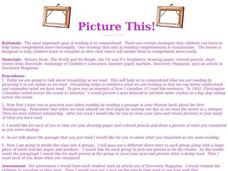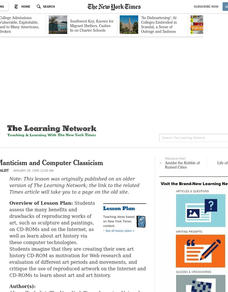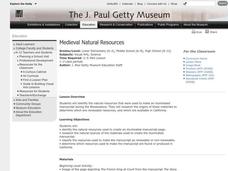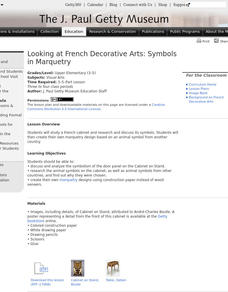Curated OER
Portraiture
Students explore the conventions of portraiture and the technique of photo-montage. In this art analysis lesson plan, students define portraiture and analyze the pictured pieces of art. Students make a photo-montage portrait or...
Curated OER
Children Respond to Haring's Work
Pupils respond to a Keith Haring exhibit at a local museum. In this art criticism activity, students create a postcard to send to the museum, sharing what they learned on their field trip.
Curated OER
Picture This!
Students practice the strategy of visualization to aid in their reading comprehension of text. They paint mental pictures from readings from their history books, "The World and Its People: the US and It's Neighbors," and short stories...
Curated OER
Objects of Adornment
Young scholars examine the portrait of two historical princesses. In this art history lesson, students define the term "adornment" and discuss the characteristics of each painting. Young scholars compare and contrast the objects worn by...
Curated OER
Social Studies: Adinkra Printing
First graders demonstrate a sense of artistic composition by creating shapes and symbols in the pattern of African Adinkra printing. They use glue to create a raised design and then print it on colored paper. Students use symbols from...
Curated OER
Redo the Playground
Students redesign a classic piece of playground equipment. In this architecture lesson students take existing designs and formulate additions or changes for improvements. Students translate their ideas into visual form and communicate...
Curated OER
CD-ROManticism and Computer Classicism
Students assess the many benefits and drawbacks of reproducing works of art, such as sculpture and paintings, on CD-ROMs and on the Internet, as well as explore art history via these computer technologies.
Curated OER
Breathing New Life into Old Traditions
Students investigate the role of ceremonies and other traditions of Native American cultures. They research various Native American nations and create posters that visually depict their research.
Curated OER
Medieval Natural Resources
Students identify and research natural resources used in art. In this Renaissance art materials instructional activity, students look at examples of illuminated manuscripts and learn what materials were used to create the books. Then,...
Curated OER
Putting a Spin on Current Events
Students examine the symbolism on a 17th-century cabinet. In this symbolism lesson, students view samples of a 17th century cabinet and identify it's symbols. Students create their own cabinet by using various art supplies and paint...
Curated OER
Ecosystem Tumble
Learners create visual representations of ecosystems. In this ecology lesson, students discuss the interdependence of plants and animals in various ecosystems. Learners cut pictures from magazines and glue them on sturdy blocks. Using...
Curated OER
A Bug's Journey
Students research the art of John Baldessari. In this art history lesson, students examine Baldessari's drawing of a beetle and discuss the characteristics of these bugs. They write a story from a bug's perspective and create their own...
Curated OER
Snap! Crackle! Box!
Students develop a new cereal and design a box for it. In this art and design lesson, students complete a year-end cumulative activity in which the use all of their artistic skills to develop a new cereal. They use their marketing skills...
Curated OER
Wish Boxes
I love these are lesson ideas! Young artists practice the art of Calligraphy and Origami. They make gift boxes with good wishes. This plan includes an excellent component that shows exactly how to fold the paper in order to make the box,...
Curated OER
Remembrance Through Art
Students examine the design for the Vietnam Veterans Memorial. They assess art's role in history. They demonstrate their knowledge by planning a memorial for a public space.
Curated OER
Youth Art Month Pins
Students design and create pins advertising Youth Art Month and incorporating mini versions of famous prints.
Curated OER
Classical Art
Students study the evolution of Greek and Roman art in pottery and human form. They examine how the artistic evolution is related to discoveries in science and travel through the lessons in this unit.
Curated OER
Clothing Color Wheel -- Lesson 2
High schoolers review the primary, secondary and tertiary colors. Using magazines and fabrics, they create a color wheel to show the correct order of colors. To end the lesson, they share their color wheels to the class and discuss why...
California Academy of Science
Fish Prints
What do a dead fish, conservation, and paint have in common? The answer is a great lesson plan about fish anatomy, fun print making techniques, and unsustainable fishing practices. The class will start by making fish prints with a...
Curated OER
Figure Study: Lesson Six
This quick lesson outline is fun and useful in developing drawing skills. Learners complete figure studies of each other. A "runway" is set up at the back of the room, and peers take turns 'striking a pose' as they are considered as...
Curated OER
Looking at French Decorative Arts: Symbols in Marquetry
High schoolers study a French cabinet, then research and discuss its symbols. They create their own marquetry design based on an animal symbol from another country.
Curated OER
Making Pencil Containers
Young scholars get their cans and their Popsicle sticks and glue a Popsicle stick to the can and continue around the can until it is covered. They paint the Popsicle sticks any color they want or decorate it any way they choose.
When...
Curated OER
How Could You Visualize the Importance of Education
Students view different pieces of art from artist Candida Alvarez. They discuss what the art means to them. They create their own mobiles showing what they would like out of their education.
Curated OER
Art and Literacy, grades 3-6, Reading Comprehension Category: Critical Stance
Students compare two very different works of art and two poems, and verbally list similarities and differences they perceive in the works of art and the poems; students then select poem that best correlates with a work of art.























